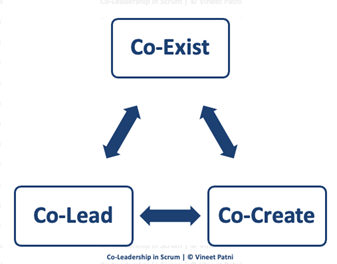
Category : Agile LeadershipScrum
By Vineet Patni | 30 April 2022
Leadership Concepts in Agile World
One of the glues that help the team stick together is effective Leadership! As a Scrum Master, one must have come across the term “Servant Leader,” which has currently given way to “True Leadership.” “Adaptive Leadership” is another term that made its way into the Scrum lexicon. Well, “Transformational Leadership” is one of the leadership styles, though as a Scrum Master, we know that effective Leadership is naturally transformational! That begets the point: how different are they from each other?
Leadership, by its very nature, is all of these and more. A True Leader, in the broader sense, will teach and help inculcate all the qualities required to make the role effective. A true leader will also be transformative.
That brings us to the question: Who is “the Leader” of the Scrum team? The answer mostly veers towards the Scrum Master since the roles and responsibilities define the individual. It is akin to stating someone as an accidental Project Manager or someone who became a project manager by accident.
What is Co-leadership?
Co-Leadership is all about shared responsibilities that turn into great partnerships! Co-leadership also means Collaborative Leadership, and the assimilation of leaders within a team enhances the power of “together.” However, the question remains, is it only about the Leadership or Management groups or the “Team” itself?
The fundamental essence of Co-Leadership is empowerment! Each team member is empowered to make decisions or put forward a view that would benefit the entire team. A more substantive definition of Co-Leadership would be two or more individuals sharing authority and influence over a company or a project rather than a single leader. They share ownership of the team’s goals but divide the roles and responsibilities.
Success stories of Co-Leadership
~ Apple, Inc: The co-founders of Apple, Inc., Steve Jobs, and Steve Wozniak, are some of history’s most inspiring success stories. With their combined creativity, passion, and dedication to their craft, these two men have achieved extraordinary successes that reverberate even today.
~ Infosys: In 1981, NR Narayana Murthy and six other engineers pooled $250 to start a software company. Today, this company is known as Infosys and has become a successful tech giant. From poverty to affluence, Murthy and his co-founders have navigated through difficult times with hard work and dedication.
~ Scrum: The co-founders of Scrum, Ken Schwaber, and Jeff Sutherland, have seen massive success with their internationally renowned project management system. Some of the most successful companies have adopted Scrum, which is now one of the leading techniques for managing complex projects.
Who are the co-leaders in Scrum?
The Scrum Guide (Nov 2020) states,
~ “Scrum was developed in the early 1990s and was built upon the collective intelligence of the people using it.”
~ “The Scrum Team turns a selection of the work into an Increment of value during the Sprint.”
~ “The Scrum Team and the stakeholders inspect the results and adjust for the next Sprint.”
A Guide to Collaborative Leadership, a TedTalk by Lorna Davis, delved into the intricacies of team management. She used the term “radical Interdependence. Individually, the two words mentioned here are transformative by themselves.
~ Radical: something that challenges the core of beliefs, and
~ Interdependence: relying on others to fulfill a goal or objective.
The 7 Habits of Highly Effective People illustrates this study further. Radical Interdependence was, therefore, the process where a team depends on each other to achieve what it set out to achieve. So, with that, it brings us to our next burning question!
How can Scrum Masters help?
The position of a Scrum Master encompasses a wide variety of viewpoints and responsibilities. A good Scrum Master is aware of these practices. He knows when and how to use them, considering the circumstances. Everything is done to enhance people’s comprehension of the Scrum framework and their ability to use it.
The usual answer would be to remove impediments, set boundaries, and assist the team in achieving goals within the accepted criteria. However, the primary task of the Scrum Master is to empower each one and create a link between all the team members. The term “Radical Interdependence” appears again, and chanting and following the Agile Mantra is the key.
§ Aligned Visions and goals that seem like they are impossible to achieve alone
The pillar of success for any project is teamwork. It is often an invisible factor, but it is all that is there. A team can only complete its project successfully with the bulwark of the entire team working together. A payment gateway would not be a great example since a single person can build it, and making Pune the Agile capital of India is impossible for a single person. Hence, you would need a team that believes in the goal and the Interdependence required to make it possible.
§ Declare Goals even before there is a plan in place
This idea is so radically exemplary that it could be called a game-changer. The planning comes after the goal is set but walking the first step is what matters the most. It calls for the confidence one has in the team an,d the confidence and latent energy one carries.
§ Help them see everyone as collaborators, not competitors. Think Win-Win.
A team with in-team competition to outsmart each other will be outsmarted by one another. Help the team members see everyone as collaborators, not competitors. Team members are supposed to be collaborators, assisting each other in overcoming challenges. One cannot compete with the other to earn brownie points; the only loser out here would be the whole team. The central pillar of radical Interdependence is pushing each other to achieve greatness and excellence. Only collaboration can move walls. Some of the best technology the world goes ga-ga about came about through innate partnerships. Most wonders of the world were collaborations too.
§ Identify and solve shared problems, not just work on shared goals.
Every team faces unexpected challenges, and to overcome them and march ahead, the team must work together. Challenges must be addressed only to individuals since, as discussed in the earlier mantra: aligned visions and goals would only be possible to achieve.
So, what’s the answer to the question: Are we in this together?
It is a yes, and this mantra answers it perfectly.
To make a great beginning, the Scrum Master must remove the mindset associated with “I.” The “I” causes the most significant challenges in a team and must be “We” all through.
§ Decisions around core values. No opt-out.
Teams who do not stay fixed on their core values do not make great teams. Core values are those that act as the fulcrum, and it provides the necessary push toward the betterment of the project. There cannot be any easy way to achieve the objectives, and opting out of the core values is simply a no. Any comprise on the values would belittle the basic premise of teamwork and may create disillusionment.
§ Align overall structure & governance with a co-leading setup
The most challenging part of changing mindsets is the change within. Organizations must create an atmosphere of radical Interdependence and co-leadership. One of the first changes that must take place is taking the individual appraisal out of the picture. It, by its very nature, violates the basic tenet of teamwork.
An appraisal creates unwarranted competition among team members, leading to the team’s breakdown. The tragedy of this mantra is that every conventional organization will never opt for co-leading. As radical as it may sound, the way forward is team appraisals, and one may also include appraised “behavior” over “performance.”
Appraising the Team performance appraisal Individual behavior adheres to the shared core values that one cannot opt out of. Bringing this change to the appraisal system is a long journey and would require much effort and patience. Legacy companies tend to stay put to older beliefs and view this change unfavorably.
§ Make everyone feel like a necessary part of the “System.”
While this may sound rudimentary, from a broader perspective, it is the most important mantra to be remembered. The “system” out here may be the whole world, and the individual is essential to this entire planet and its vast ecosystems. The effectiveness of Scrum Master depends mainly on the way they articulate everyone’s importance.
§ Invite to Co-create and co-leading
It is like going out and telling people that “we” are in this together and whatever challenges that befall “us” will be solved “together.” By co-creating and co-leading, one is sharing the expertise and the team’s idea! While the Scrum Guide provides one with practical elements, the agile mantra tells you the importance of teamwork at a human level.
Putting all these together
The Agile Mantra sums up teamwork through three building blocks: Co-exist – Co-Create – Co-Lead. These three are radically interdependent and mutually inclusive.

Co-exitance is the driving force to perform operations requiring more than one hand. Coexistence is the key to a fruitful outcome, whether looking after one’s family or raising children! By co-existing, one is also inviting the others to co-create and co-lead.
A team can achieve its objectives only through this shared responsibility. One might question the role of the Scrum Master here, and that is justifiable. The Scrum Master is the pivot who drives the idea of jointness, and they will act as the pillar around which the team will perform together.
Rather than be future-ready, let us TOGETHER co-create and co-lead the world into that beautiful future
About The Author:
Vineet Patni is the Founder and Principal Agile Coach at ScaleUp. An avid learner and a passionate facilitator, Vineet has been assisting enterprises and individuals in becoming truly Agile. Please feel free to connect with him at Vineet@ScaleUpConsultants.com .
Disclaimer: The opinions expressed in this post are the author’s own. The author welcomes and respects any difference of opinion.


Leave a Reply